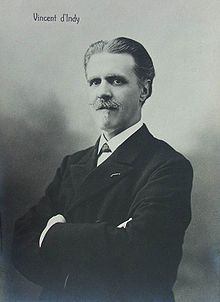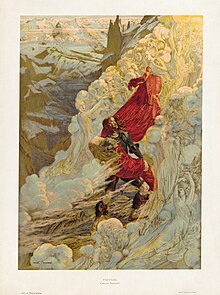Vincent d'Indy

Paul Marie Théodore Vincent d'Indy(French:[vɛ̃sɑ̃dɛ̃di];27 March 1851 – 2 December 1931) was a French composer and teacher. His influence as a teacher, in particular, was considerable. He was a co-founder of theSchola Cantorum de Parisand also taught at theParis Conservatoire.His students includedAlbéric Magnard,Albert Roussel,Arthur Honegger,Darius Milhaud,Yvonne Rokseth,andErik Satie,as well asCole Porter.
D'Indy studied under composerCésar Franck,and was strongly influenced by Franck's admiration for German music. At a time when nationalist feelings were high in both countries (circa theFranco-Prussian Warof 1871), this brought Franck into conflict with other musicians who wished to separate French music from German influence.
Life
[edit]Paul Marie Théodore Vincent d'Indy was born in Paris into an aristocratic family ofroyalistandCatholicpersuasion. He had piano lessons from an early age from his paternal grandmother, who passed him on toAntoine François MarmontelandLouis Diémer.[1]
From the age of 14 d'Indy studied harmony withAlbert Lavignac.When he was 16 an uncle introduced him toBerlioz'streatise on orchestration, which inspired him to become a composer.[2]He wrote a piano quartet which he sent toCésar Franck,who was the teacher of a friend. Franck recognised his talent and recommended that d'Indy pursue a career as a composer.[2]
At the age of 19, during theFranco-Prussian War,d'Indy enlisted in the National Guard, but returned to musical life as soon as the hostilities were over. He entered Franck's organ class at theConservatoire de Parisin 1871 remaining there until 1875, when he joined the percussion section of the orchestra at theChâtelet Theatreto gain practical experience. He also served as chorus-master to theConcerts Colonne.[2]

The first of his works he heard performed was aSymphonie italienne,at an orchestral rehearsal underJules Pasdeloup;the work was admired byGeorges BizetandJules Massenet,with whom he had already become acquainted.[1]
During the summer of 1873 he visited Germany, where he metFranz LisztandJohannes Brahms.On 25 January 1874, his overtureLes Piccolominiwas performed at a Pasdeloup concert, sandwiched between works byBachandBeethoven.[1]Around this time he married Isabelle de Pampelonne, one of his cousins. In 1875 his symphony dedicated toJános Hunyadiwas performed. That same year he played a minor role – the prompter – at the premiere of Bizet's operaCarmen.[1]In 1876 he was present at the first production ofRichard Wagner'sRingcycleatBayreuth.This made a great impression on him and he became a fervent Wagnerian.[3]
In 1878 d'Indy's symphonic balladLa Forêt enchantéewas performed.[4]In 1882 he heard Wagner'sParsifal.In 1883 his choral workLe Chant de la clocheappeared. In 1884 his symphonic poemSaugefleuriewas premiered. His piano suite ( "symphonic poem for piano" ) calledPoème des montagnescame from around this time. In 1887 appeared his Suite in D for trumpet, 2 flutes and string quartet. That same year he was involved in Lamoureux's production of Wagner'sLohengrinas choirmaster. His music dramaFervaaloccupied him between 1889 and 1895.[3]

Inspired by his studies with Franck and yet dissatisfied with the standard of teaching at the Conservatoire, d'Indy, together withCharles BordesandAlexandre Guilmant,founded theSchola Cantorum de Parisin 1894.[3]D'Indy taught there until his death, becoming principal in 1904.[3]Of the teaching at the Schola Cantorum,The Oxford Companion to Musicsays, "A solid grounding in technique was encouraged, rather than originality", and comments that few graduates could stand comparison with the best Conservatoire students.[5]D'Indy later taught at the Conservatoire and privately, while retaining his post at the Schola Cantorum.[3]
Among d'Indy's renowned pupils wereAlbéric Magnard,Albert Roussel,Joseph Canteloube(who later wrote d'Indy's biography),Celia Torra,[6]Arthur HoneggerandDarius Milhaud.[n 1]Two atypical students wereCole Porter,who signed up for a two-year course at the Schola, but left after a few months,[7]andErik Satie,who studied there for three years and later wrote, "Why on earth had I gone to d'Indy? The things I had written before were so full of charm. And now? What nonsense! What dullness!"[8]Nonetheless, according toGrove's Dictionary of Music and Musicians,d'Indy's influence as a teacher was "enormous and wide-ranging, with benefits for French music far outweighing the charges of dogmatism and political intolerance".[3]
D'Indy played an important part in the history of theSociété nationale de musique,of which his teacher, Franck, had been a founding member in 1871.[9]Like Franck, d'Indy revered German music, and he resented the society's exclusion of non-French music and composers.[9]He became the society's joint secretary in 1885,[3]and succeeded in overturning its French-only rule the following year. The founders of the society,Romain BussineandCamille Saint-Saënsresigned in protest.[9]Franck refused the formal title of president of the society, but when he died in 1890, d'Indy took the post. His regime, however, alienated a younger generation of French composers, who, led byMaurice Ravel,founded the breakawaySociété musicale indépendantein 1910, which attracted leading young composers from France and other countries.[10]In an attempt to further a proposed merger of the two organisations during theFirst World Ward'Indy stepped down as president of the Société nationale to make way for the more "progressive"Gabriel Fauré,but the plan came to nothing.[10]
According to the biographerRobert Orledge,the death of d'Indy's first wife in 1905 removed the stabilising influence in the composer's life, and he became "increasingly vulnerable to politically motivated attacks on the Schola Cantorum and apprehensive of dangerously decadent trends in contemporary music in both France and Germany". His aesthetic ideas, Orledge argues, became "increasingly reactionary and dogmatic" and his political views right-wing andanti-Semitic.He joined theLigue de la patrie française(League of the French Fatherland) during theDreyfus affair.[3]

During theFirst World Ward'Indy served on cultural missions to allied countries, and completed his third music drama,La Légende de Saint-Christophe,in Orledge's view "a celebration of traditional Catholic regionalism as opposed to modern liberal democracy and capitalist values".[3]After the war he increased his activities as a conductor, giving concert tours throughout Europe and the US. 1920 he married the much younger Caroline Janson; Orledge writes that this "brought a true creative rebirth, witnessed in the serene Mediterranean-inspired compositions of his final decade".[3]
D'Indy died on 2 December 1931 in his native Paris, aged 80, and was buried in theMontparnasse Cemetery.[11]
Works
[edit]Few of d'Indy's works are performed regularly in concert halls today.Grovecomments that his famed veneration for Beethoven and Franck "has unfortunately obscured the individual character of his own compositions, particularly his fine orchestral pieces descriptive of southern France".[3]Among his best known pieces are theSymphony on a French Mountain Airfor piano and orchestra (1886), andIstar(1896), asymphonic poemin the form of a set ofvariationsin which the theme appears only at the end.[1]

Among d'Indy's other works are more orchestral pieces, including a Symphony in B♭,a vast symphonic poem,Jour d'été à la montagne,and another,Souvenirs,written on the death of his first wife.The Timessaid of his music that the influence of Berlioz, Franck, and Wagner is strong in almost all his work, "that of Franck showing itself chiefly in the shapes of his tunes, that of Wagner in their development, and that of Berlioz in their orchestration".[2]
Grovesays of his chamber works: "D'Indy's somewhat academic corpus of chamber music (including three completed string quartets) is generally less interesting than his orchestral works". He also wrote piano music (including a Sonata in E minor), songs and a number of operas, includingFervaal(1897) andL'Étranger(1902). His music dramaLe Légende de Saint Christophe,based on themes fromGregorian chant,was premiered at theParis Opéraon 6 June 1920.[2][3]
D'Indy helped revive a number of then largely forgotten Baroque works, for example making his own edition ofMonteverdi's operaL'incoronazione di Poppea.[3]D'Indy also contributed to the incipient revival of the works ofAntonio Vivaldi,whose sonatas for cello and basso continuo (op. 14) were edited by d'Indy as cello concerti and published byMaurice Senartin 1922.[12]His musical writings include the three-volumeCours de composition musicaleas well as studies of Franck andBeethoven.[3]The Timescommented that his study of the former was "one of the most vivid and individual of modern French biographies", and the latter, published in 1912, showed "the closeness of the lifelong study which he devoted to that master".[2]
Commemorations
[edit]The private music collegeÉcole de musique Vincent-d'IndyinMontreal,Canada, is named after the composer,[13]as is the asteroid11530 d'Indy,discovered in 1992.[14]
Notes, references and sources
[edit]Notes
[edit]References
[edit]- ^abcde"Indy, Vincent d'",Grove's Dictionary of Music and Musicians,5th edition, 1954, volume V,Eric Blomed.
- ^abcdef"M. Vincent d'Indy",The Times,4 December 1931, p. 16
- ^abcdefghijklmnOrledge, Robert, and Andrew Thomson."Indy, (Paul Marie Théodore) Vincent d'",Grove Music Online,Oxford University Press, 2001(subscription required)
- ^"Courrier des théâtres",Le Figaro,22 March 1878, p. 3
- ^"Schola Cantorum",The Oxford Companion to Music,edited by Alison Latham, Oxford University Press, 2011.
- ^Cohen, Aaron I. (1987).International encyclopedia of women composers(Second edition, revised and enlarged ed.). New York.ISBN0-9617485-2-4.OCLC16714846.
{{cite book}}:CS1 maint: location missing publisher (link) - ^McBrien, p 94; and Citron, p. 56
- ^Templier, p. 32
- ^abcCochard, Alain."150ème anniversaire de la naissance de la Société nationale de musique",Concertclassic.com. Retrieved 13 May 2021
- ^abDuchesneau, Michel."Maurice Ravel et la Société Musicale Indépendante: 'Projet Mirifique de Concerts Scandaleux'",Revue de Musicologie,vol. 80, no. 2, 1994, pp. 251–281(subscription required);and"La musique française pendant la Guerre 1914–1918: Autour de la tentative de fusion de la Société Nationale de Musique et de la Société Musicale Indépendante",Revue de Musicologie,1996, T. 82, No. 1, p. 148(subscription required)
- ^"Les obsèques de Vincent d'Indy",Comoedia,5 December 1931, p. 2
- ^Sonates en concert: Sonate 5,Paris: Senart, 1922,OCLC1114800864,retrieved18 July2022
- ^"Historique",École de musique Vincent-d'Indy, 2021. Retrieved 15 May 2021
- ^"(11530) d'Indy",International Astronomical Union Minor Planet Center. Retrieved 15 May 2021
Sources
[edit]- Blom, Eric (1954).Grove's Dictionary of Music and Musicians(fifth ed.). New York: St Martin's Press.OCLC1192249.
- Citron, Stephen (1993).Noël and Cole: The Sophisticates.New York: Oxford University Press.ISBN978-0-19-508385-9.
- McBrien, William (1998).Cole Porter.New York: Knopf.OCLC1148597196.
- Templier, Pierre-Daniel (1969).Erik Satie.Cambridge, Mass: MIT Press.OCLC1034659768.
Further reading
[edit]- Norman Demuth,Vincent d'Indy: Champion of Classicism(London, 1951)
- Steven Huebner,Vincent d'Indy and Moral Order' and 'Fervaal': French Opera at the Fin de Siècle(Oxford, 1999), pp. 301–08 and 317–50
- Vincent d'Indy (Marie d'Indy, ed.),Vincent d'Indy: Ma Vie. Journal de jeunesse. Correspondance familiale et intime, 1851–1931(Paris, 2001).ISBN2-84049-240-7
- James Ross,'D'Indy's "Fervaal": Reconstructing French Identity at the Fin-de-Siècle',Music and Letters84/2 (May 2003), pp. 209–40
- Manuela Schwartz(ed.),Vincent d'Indy et son temps(Sprimont, 2006).ISBN2-87009-888-X
- Andrew Thomson,Vincent d'Indy and his World(Oxford, 1996)
- Robert Trumble,Vincent d'Indy: His Greatness and Integrity(Melbourne, 1994)
- Huebner, Steven (2006).French Opera at the Fin de Siècle: Vincent d'Indy.Oxford Univ. Press, US. pp. 301–350.ISBN978-0-19-518954-4.
External links
[edit]- Works by or about Vincent d'Indyat theInternet Archive
- D'Indy Trio for Clarinet, Cello & Piano, Op. 29, Piano Quartet Op. 7, String Quartet No. 1 and String Sextet, Op. 92 soundbites and discussion of works
- Free scores by Vincent d'Indyat theInternational Music Score Library Project(IMSLP)
- Free scores by Vincent d'Indyin theChoral Public Domain Library(ChoralWiki)
- Performance of Lied for cello and orchestraonYouTubebyJulian Lloyd Webberand theEnglish Chamber Orchestraconducted byYan Pascal Tortelier
- 1851 births
- 1931 deaths
- 19th-century French classical composers
- 19th-century French male musicians
- 20th-century French classical composers
- 20th-century French male musicians
- Academic staff of the Conservatoire de Paris
- Burials at Montparnasse Cemetery
- Conservatoire de Paris alumni
- French male classical composers
- French male non-fiction writers
- French Roman Catholics
- French Romantic composers
- Composers for piano
- Members of the Ligue de la patrie française
- Musicians from Paris
- Pupils of Antoine François Marmontel
- Pupils of César Franck
- Academic staff of the Schola Cantorum de Paris
